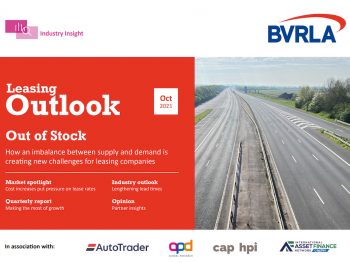BVRLA confident of leasing sector growth in 2022
The UK leasing sector continues to bounce back from the pandemic challenges and is on track for growth in 2022.

The BVRLA’s Leasing Outlook Report shows positive developments in industry confidence, fleet emissions and growth of the van sector
That’s according to new figures from the BVRLA showing positive developments in industry confidence, fleet emissions and growth of the van sector.
Its new Leasing Outlook Report reveals that industry confidence is up year on year and is expected to improve further in 2022 as order banks remain strong in spite of extended lead times.
The total BVRLA fleet is forecast to grow 3% by Q2 2022 as the sector continues its post-lockdown resurgence in the face of global vehicle supply challenges.
The picture for van fleet growth is even more positive; it leapt 9.1% year-on-year during Q2 2021 to 463,638 vehicles, a new record. Most of this demand came through business contract hire. The figures show how the fleet sector focus is shifting to vans due to factors such as home delivery continuing to grow as lockdown consumer habits have become embedded.
And while the total BVRLA car fleet fell 3.3% year-on-year in Q2 2021 as a result of lower corporate demand, uptake of zero-emission vehicles soared over the same period.
Chief executive Gerry Keaney said: “The resilience of the leasing sector is creating greater levels of confidence within the industry, giving us many reasons to be optimistic going into 2022. Despite ongoing difficulties sourcing new vehicles, members have still been able to make progress in electrifying their fleets to improve the sector’s sustainability credentials.”
This has contributed to average emissions of the BVRLA fleet reaching their lowest-ever levels – 110.1g/km – thanks to battery electric vehicles (BEV) and plug-in hybrids (PHEV) making up over a third of new orders over the last year. It is forecast that one in four cars on fleet will be either BEV or PHEV by Q2 2022, following the exceptional growth this year.
Keaney continued: “To see the green credentials of the BVRLA fleet improve to achieve record-low emissions is incredibly encouraging. As well as the supply issues, uncertainty remains regarding residual values and long-term tax rates. That said, the sector is in a healthy position and continues to drive the industry towards meeting ambitious government targets.”
Five key findings from the BVRLA Leasing Outlook:
Demand for vans and personal leasing countering declining business contract hire (BCH) demand
The BVRLA fleet remained broadly unchanged in Q2 2021 compared to the same period last year (-0.4% year-on-year), as falling demand for BCH was offset by continuing growth in personal leasing and van sales.
Business car sector is vital force behind falling emissions
Despite its shrinking size, the business car sector accounts for the majority of plug-in vehicle demand, and as a result was instrumental in reducing BVRLA car fleet CO2 emissions. BVRLA average car fleet emissions returned to a historic low of 110.1g/km in Q2 2021, the level first achieved two years ago before a spike in official emissions figures was caused by the introduction of the WLTP test regime. New car registrations were down to 92.2g/km during Q2 2021, compared to 109g/km for the same period last year. Van emissions remain roughly unchanged year-on-year, but could well drop in the next year.
Surge in confidence despite fears of shortages and price rises
Leasing executives are cautious but confident about the road ahead for the leasing industry. Although shortages could limit supply, they are seeing strong demand from customers which is expected to underpin an economic recovery. The majority say they expect the UK economy to improve in the next six months.
Contracted mileage and duration increase across car leasing market
Both the consumer and business lease segments have seen an increase in average contracted mileage compared to the same period in 2020. Business car contract hire is just under 56,000 miles and 39 months, compared to 51,300 miles and 38 months in last year’s Q2 report. Contracts for consumer leasing increased from an average of 26,000 miles in Q2 2020 to nearly 31,000 in the same period of 2021. Average contract length was static at 37 months.
Demand for maintained contracts rises
The proportion of the BVRLA business car fleet with maintained contracts has increased slightly in the past year. Overall, 75% of business contract hire is provided with maintenance contracts, compared to 73% in Q2 2020. A total of 71% of new business contract hire agreements have maintenance included, which is unchanged from a year ago
To access the BVRLA Leasing Outlook Report, click here.












